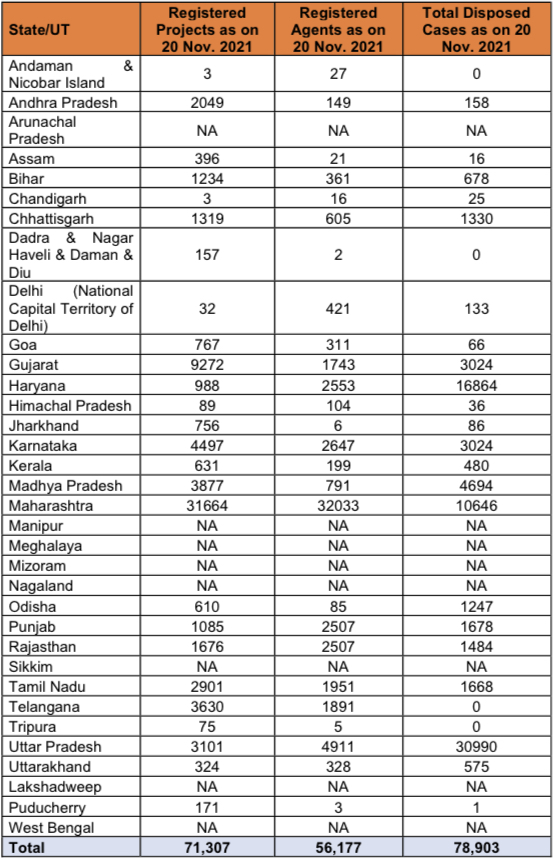UP (Uttar Pradesh) has disposed the highest number of cases that came to the state’s RERA body. UP disposed 30,990 cases
By Varun Singh
In the approx. 4.5 years since RERA was fully notified, 71,307 projects have been registered under it across the country as of November 2021. Maharashtra, Gujarat and Karnataka lead in project registrations till date with 31,664, 9,272 and 4,497 projects registered respectively.
In terms of grievances redressal of aggrieved homebuyers, as many as 78,903 cases have been disposed so far by various state and UT regulatory authorities. UP and Haryana have disposed the highest number of cases, accounting for an approx. 61% share of total disposed cases. UP saw 30,990 cases disposed, and Haryana nearly 16,864 as per the latest progress report released by the Ministry of Housing and Urban Affairs.
Latest Updates
- All States/UTs have notified rules under RERA except Nagaland, where it is under process
- 30 States/UTs have set up a Real Estate Regulatory Authority (Regular – 25, Interim – 05). Jammu & Kashmir, Ladakh, Meghalaya, Sikkim and West Bengal have notified their rules but are yet to establish their authorities
- 28 States/UTs have set up a Real Estate Appellate Tribunal (Regular -24, Interim – 04). Arunachal Pradesh, Jammu & Kashmir, Ladakh, Meghalaya, Mizoram, Sikkim and West Bengal are under process to establish
- Regulatory Authorities of 27 States/UTs have operationalized their websites under the provisions of RERA. (Arunachal Pradesh, Assam and Manipur are under process to operationalize).
More Projects Under RERA Ambit
Very recently, the Supreme Court upheld the jurisdiction of the Real Estate (Regulation & Development) Act, 2016 on all realty projects that were ongoing and had not received Completion Certificates until the law came into effect. This means that states that had diluted the provisions and not included many under-construction projects under RERA ambit are now expected to bring such projects under it.
Anuj Puri, Chairman – ANAROCK Group says, “RERA rules had been diluted in many states and many under-construction projects not completed at the time of RERA’s implementation did not come within its ambit. Through this verdict, the court has given more powers to RERA, and it now covers such under-construction projects as well.”
“As a result, we may see increased residential project completions in the times to come,” says Puri. “Many developers with under-construction projects outside RERA had focused their resources on projects that did come under its ambit. This is no longer an option. The number of heavily delayed and even stalled units is likely to reduce. As per ANAROCK data, as of July 2021, nearly 6.29 lakh housing units launched in 2014 or before were incomplete or stalled across the top 7 cities.”
Another key issue addressed by the Supreme Court earlier was regarding the provision of appeal for developers whom RERA has fined. Previously, the appeal option was often used as a reason to delay matters. It has now been clarified that while fined developers can appeal, they must nevertheless deposit at least 25% of the fine amount with RERA.
As has been pointed out, RERA is a process, not an event. This process is well underway and RERA is gaining ground – and teeth. The primary purpose of rebuilding confidence in the real estate sector is thus being fulfilled, albeit gradually, as RERA must undo the damage of decades of opaque and unregulated activities in the sector.

Also Read: Conciliation Bench of MahaRERA gets 60 days to solve Problems Between Builder and Homebuyers









